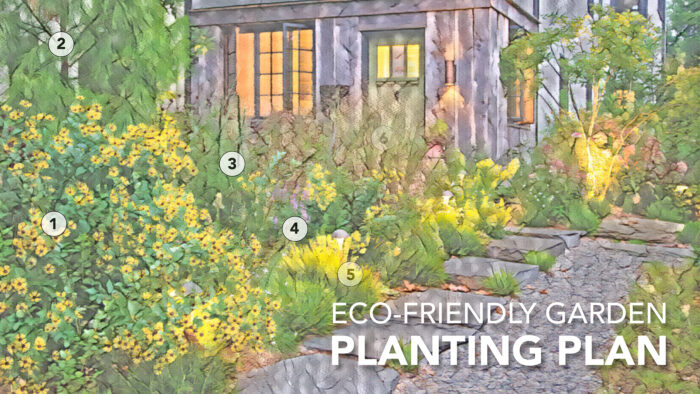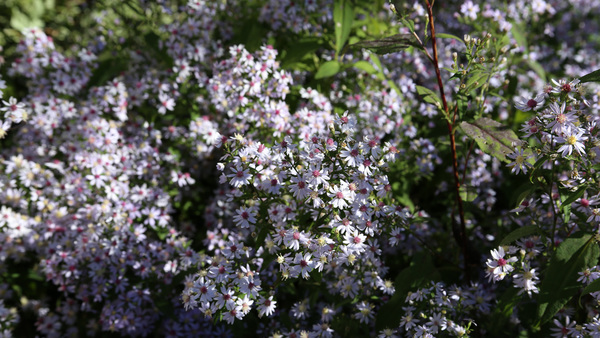
When Jeff Lorenz and Kayla Fell first purchased their small lot in Narberth, Pennsylvania, it was overrun with invasive plants and had major issues with flooding. They transformed this area into a hardworking garden that is seamlessly integrated with the surrounding ecosystem. Full of densely planted natives, permeable hardscaping, and a no-mow sedge and fescue lawn, their property now serves as a haven for pollinators and wildlife. With something interesting going on during all four seasons and plenty of privacy and outdoor living spaces, it’s also a perfect oasis for their young family in the Philadelphia suburbs. Look below for some of the plants that went into this robust, environmentally sustainable design. Learn about the design and see more of this garden here.
1. ‘Little Henry’ sweet coneflower (Rudbeckia subtomentosa ‘Little Henry’, Zones 4–8)
2. Pond cypress (Taxodium ascendens, Zones 5–9)
3. ‘Lady in Black’ calico aster (Symphyotrichum lateriflorum ‘Lady in Black’, Zones 4–8)
4. ‘Purple Haze’ agastache (Agastache ‘Purple Haze’, Zones 6–9)
5. ‘Suwannee’ blue-eyed grass (Sisyrinchium angustifolium ‘Suwannee’, Zones 6–9)
6. ‘Purple Tears’ switchgrass (Panicum virgatum ‘Purple Tears’, Zones 4–10)
7. Coastal plain Joe Pye weed (Eupatorium dubium, Zones 3–9)
8. ‘Winter Red’ winterberry (Ilex verticillata ‘Winter Red’, Zones 3–9)
9. Showy goldenrod (Solidago speciosa, Zones 3–8)
10. Leavenworth’s sedge (Carex leavenworthii, Zones 6–9)
1. Moonglow® sweetbay magnolia (Magnolia virginiana ‘Jim Wilson’, Zones 5–10)
2. ‘Major Wheeler’ honeysuckle (Lonicera sempervirens ‘Major Wheeler’, Zones 4–8)
3. Proud Berry® coralberry (Symphoricarpos ‘Sofie’, Zones 3–7)
4. Pond cypress
5. Umbrella magnolia (Magnolia tripetala, Zones 5–8)
6. Silver eastern red cedar (Juniperus virginiana ‘Glauca’, Zones 3–9)
7. Red fescue (Festuca rubra cv., Zones 2–7)
8. Eastern bluestar (Amsonia tabernaemontana, Zones 4–9)
9. ‘Halley’s Comet’ Florida anise (Illicium floridanum ‘Halley’s Comet’, Zones 7–10)
10. Pagoda dogwood (Cornus alternifolia, Zones 3–7)
1. ‘Suwannee’ blue-eyed grass
2. ‘Husker Red’ penstemon (Penstemon digitalis ‘Husker Red’, Zones 3–8)
3. Red buckeye (Aesculus pavia, Zones 4–8)
4. Hubricht’s bluestar (Amsonia hubrichtii, Zones 5–8)
5. ‘Shenandoah’ switchgrass (Panicum virgatum ‘Shenandoah’, Zones 5–9)
6. American hornbeam (Carpinus caroliniana, Zones 3–9)
Diana Koehm is the assistant editor.
Fine Gardening Recommended Products

Attracting Beneficial Bugs to Your Garden, Revised and Updated Second Edition: A Natural Approach to Pest Control
Fine Gardening receives a commission for items purchased through links on this site, including Amazon Associates and other affiliate advertising programs.

Planting in a Post-Wild World: Designing Plant Communities for Resilient Landscapes
Fine Gardening receives a commission for items purchased through links on this site, including Amazon Associates and other affiliate advertising programs.

Buffalo-Style Gardens: Create a Quirky, One-of-a-Kind Private Garden with Eye-Catching Designs
Fine Gardening receives a commission for items purchased through links on this site, including Amazon Associates and other affiliate advertising programs.





















Comments
Log in or create an account to post a comment.
Sign up Log in